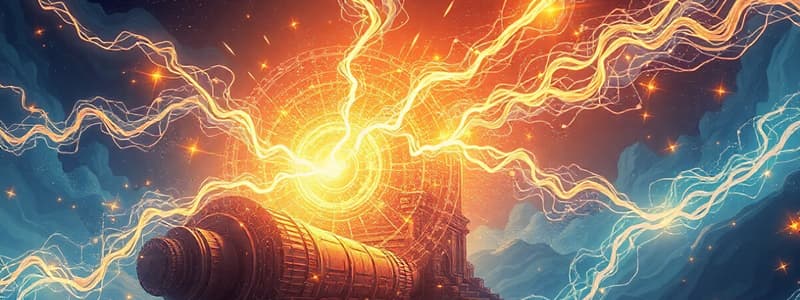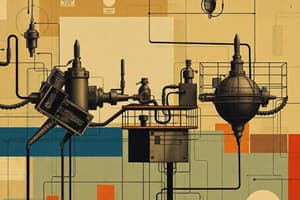Podcast
Questions and Answers
What is the main function of the stator in a DC machine?
What is the main function of the stator in a DC machine?
- To induce electromotive force
- To conduct current to the armature
- To generate a magnetic field (correct)
- To provide mechanical support and protection
Which components are involved in reversing the direction of current flow in a DC machine?
Which components are involved in reversing the direction of current flow in a DC machine?
- Yoke and Bearings
- Armature and Field Windings
- Brushes and Stator
- Commutator and Brushes (correct)
What is the role of the commutator in a DC generator?
What is the role of the commutator in a DC generator?
- To convert AC into unidirectional DC (correct)
- To conduct current from the windings
- To spread magnetic flux uniformly
- To support the rotor during motion
In a DC machine design, what is the purpose of poles and pole shoes?
In a DC machine design, what is the purpose of poles and pole shoes?
Which law describes the induction of electromotive force in conductors of the armature windings?
Which law describes the induction of electromotive force in conductors of the armature windings?
What material are brushes in a DC machine primarily made from?
What material are brushes in a DC machine primarily made from?
What role do bearings play in a DC machine?
What role do bearings play in a DC machine?
What effect does the rotation of the rotor have in a DC generator?
What effect does the rotation of the rotor have in a DC generator?
What is the primary purpose of brush shifting in electrical machines?
What is the primary purpose of brush shifting in electrical machines?
Which of the following is an advantage of using interpoles in electrical machines?
Which of the following is an advantage of using interpoles in electrical machines?
What is a disadvantage of using compensating windings?
What is a disadvantage of using compensating windings?
Using high-resistance brushes primarily helps to:
Using high-resistance brushes primarily helps to:
What is the main goal of brush grade selection in electrical machines?
What is the main goal of brush grade selection in electrical machines?
Which of the following methods requires precise design adjustments?
Which of the following methods requires precise design adjustments?
What benefit does a split commutator provide?
What benefit does a split commutator provide?
What is the primary reason for adjusting the Magnetic Neutral Axis (MNA)?
What is the primary reason for adjusting the Magnetic Neutral Axis (MNA)?
Which method is not effective for severe sparking issues in electrical machines?
Which method is not effective for severe sparking issues in electrical machines?
Which part of the machine do interpoles directly impact?
Which part of the machine do interpoles directly impact?
What characterizes a single layer winding?
What characterizes a single layer winding?
What is a disadvantage of double layer winding?
What is a disadvantage of double layer winding?
What effect does armature reaction have on voltage generation?
What effect does armature reaction have on voltage generation?
Where are brushes placed in relation to the magnetic neutral axis (M.N.A.)?
Where are brushes placed in relation to the magnetic neutral axis (M.N.A.)?
What does the cross-magnetizing component of armature reaction do?
What does the cross-magnetizing component of armature reaction do?
Why might a double layer winding be used in larger machines?
Why might a double layer winding be used in larger machines?
What is a common application for single layer winding?
What is a common application for single layer winding?
What does a shift in the magnetic neutral axis (M.N.A.) indicate?
What does a shift in the magnetic neutral axis (M.N.A.) indicate?
Which of the following is NOT an advantage of double layer winding?
Which of the following is NOT an advantage of double layer winding?
How does armature reaction affect flux distribution under load conditions?
How does armature reaction affect flux distribution under load conditions?
What happens to the armature current when brushes are shifted?
What happens to the armature current when brushes are shifted?
Which characteristic differentiates a double layer winding from a single layer winding?
Which characteristic differentiates a double layer winding from a single layer winding?
What is the magnetic neutral axis primarily responsible for?
What is the magnetic neutral axis primarily responsible for?
Which option best describes armature reaction's cross magnetizing effect?
Which option best describes armature reaction's cross magnetizing effect?
What causes the torque to be generated in a DC motor?
What causes the torque to be generated in a DC motor?
Which rule determines the direction of the torque generated in a DC motor?
Which rule determines the direction of the torque generated in a DC motor?
What is the main function of the commutator in a DC motor?
What is the main function of the commutator in a DC motor?
What describes the Lorentz force in the context of DC motors?
What describes the Lorentz force in the context of DC motors?
How does the number of poles (P) affect the EMF in a DC generator?
How does the number of poles (P) affect the EMF in a DC generator?
Which type of winding is best suited for high-voltage, low-current applications?
Which type of winding is best suited for high-voltage, low-current applications?
What is a disadvantage of lap winding in DC machines?
What is a disadvantage of lap winding in DC machines?
When calculating total EMF in a DC generator, which factor does NOT directly influence it?
When calculating total EMF in a DC generator, which factor does NOT directly influence it?
What is the formula used to calculate torque in a DC motor?
What is the formula used to calculate torque in a DC motor?
Which equation relates speed, magnetic flux, and number of poles for induced EMF?
Which equation relates speed, magnetic flux, and number of poles for induced EMF?
Which aspect of the armature winding impacts the torque produced?
Which aspect of the armature winding impacts the torque produced?
What is the main advantage of wave winding over lap winding?
What is the main advantage of wave winding over lap winding?
In a DC motor, what does the armature current (Ia) directly determine?
In a DC motor, what does the armature current (Ia) directly determine?
Which of the following statements about electromagnetic induction is true?
Which of the following statements about electromagnetic induction is true?
What does the demagnetising component OFd exert on the main m.m.f OFm?
What does the demagnetising component OFd exert on the main m.m.f OFm?
What is the primary function of a commutator in a d.c. generator?
What is the primary function of a commutator in a d.c. generator?
During which phase does a coil undergo its current reversal in a d.c. generator?
During which phase does a coil undergo its current reversal in a d.c. generator?
What is the consequence of incomplete current reversal during commutation?
What is the consequence of incomplete current reversal during commutation?
What happens to the current through coil B during the short-circuiting period?
What happens to the current through coil B during the short-circuiting period?
What occurs specifically during the commutation period Tc?
What occurs specifically during the commutation period Tc?
What does ideal commutation require by the end of the commutation period?
What does ideal commutation require by the end of the commutation period?
What factor primarily retards the quick reversal of current during commutation?
What factor primarily retards the quick reversal of current during commutation?
When does sparking typically occur during the commutation process?
When does sparking typically occur during the commutation process?
How does the current behave in coil B as it progresses through the commutation process?
How does the current behave in coil B as it progresses through the commutation process?
What is the result when the current in coil B is not completely reversed during the short-circuit period?
What is the result when the current in coil B is not completely reversed during the short-circuit period?
What is the time duration generally associated with the commutation period?
What is the time duration generally associated with the commutation period?
In what condition does the reactance voltage impact the coil during commutation?
In what condition does the reactance voltage impact the coil during commutation?
Which current value does coil B ideally aim for by the end of the commutation period?
Which current value does coil B ideally aim for by the end of the commutation period?
Flashcards
Armature Reaction
Armature Reaction
Effect of armature current's magnetic field on DC generator's main field distribution.
Demagnetization
Demagnetization
Weakening of the main magnetic flux in a DC generator due to armature reaction.
Cross-magnetization
Cross-magnetization
Distortion of the main magnetic flux in a DC generator due to armature reaction.
Commutation
Commutation
Signup and view all the flashcards
Magnetic Neutral Axis (MNA)
Magnetic Neutral Axis (MNA)
Signup and view all the flashcards
Brush Shifting
Brush Shifting
Signup and view all the flashcards
Interpoles (Compoles)
Interpoles (Compoles)
Signup and view all the flashcards
Compensating Windings
Compensating Windings
Signup and view all the flashcards
High-Resistance Brushes
High-Resistance Brushes
Signup and view all the flashcards
Brush Grade Selection
Brush Grade Selection
Signup and view all the flashcards
Split Commutator
Split Commutator
Signup and view all the flashcards
Sparking at Brushes
Sparking at Brushes
Signup and view all the flashcards
Self-induced EMF
Self-induced EMF
Signup and view all the flashcards
Armature Current
Armature Current
Signup and view all the flashcards
DC Generator
DC Generator
Signup and view all the flashcards
Commutation Period
Commutation Period
Signup and view all the flashcards
Ideal Commutation
Ideal Commutation
Signup and view all the flashcards
Auxiliary Poles
Auxiliary Poles
Signup and view all the flashcards
Machines
Machines
Signup and view all the flashcards
Current Density
Current Density
Signup and view all the flashcards
Electrical Resistance
Electrical Resistance
Signup and view all the flashcards
Study Notes
Armature Reaction
- Armature reaction is the effect of the magnetic field created by the armature current on the main field distribution in a DC generator.
- It has two main effects:
- Demagnetization: Weakens the main flux, leading to reduced generated voltage.
- Cross-magnetization: Distorts the main flux, causing sparking at the brushes.
- The strength of both effects increases with armature current.
Commutation
- Commutation is the process of reversing the current in an armature coil as it moves from one pole to the other in a DC machine.
- It occurs when the coil is short-circuited by the brush as it crosses the magnetic neutral axis (M.N.A.).
- The ideal commutation is when the current reversal is completed within the commutation period (Tc).
- Sparkling at the brushes is caused by incomplete current reversal during the commutation period.
- The main factor delaying current reversal is the self-induced EMF (reactance voltage) in the coil, which is caused by the coil's inductance.
Commutation in Electrical Machines
- A small voltage can cause a large current through a coil due to low resistance caused by a short circuit.
- Even when there is no induced e.m.f. due to armature rotation, self-induction causes sparking at brushes.
- Improving commutation is key to enhance performance, reduce sparking, and increase the lifespan of commutators and brushes.
Methods to Improve Commutation
-
Brush Shifting:
- Adjusting the position of the brushes can improve commutation timing.
- Advantages: simple, cost-effective.
- Disadvantages: only effective for minor adjustments, not suitable for severe sparking.
-
Interpoles (Compoles):
- Small auxiliary poles positioned between the main poles.
- Wound with heavy wire and connected in series with the armature.
- Advantages: neutralize armature reaction, significantly improving commutation.
- Disadvantages: adds to the complexity and cost of the machine.
-
Compensating Windings:
- Located in the slots of the main pole faces, connected in series with the armature.
- Produce a magnetic field opposing armature reaction.
- Advantages: effective in large machines with significant armature reaction.
- Disadvantages: increases complexity and cost of the machine.
-
High-Resistance Brushes:
- Have higher electrical resistance.
- Advantages: reduces current density, smoother current reversal, and sparking.
- Disadvantages: slightly higher losses due to resistance.
-
Brush Grade Selection:
- Different brush materials (carbon, graphite, metal-graphite) have different properties.
- Advantages: optimizes performance and lifespan of brushes and commutator.
- Disadvantages: requires careful selection based on operating conditions.
-
Magnetic Neutral Axis (MNA) Adjustment:
- Adjusting the MNA through field winding design and pole shoe shaping.
- Advantages: reduces sparking, improves commutation.
- Disadvantages: requires precise design and adjustments.
-
Split Commutator:
- Divides commutator segments into smaller parts.
- Advantages: more gradual commutation, reduced sparking.
- Disadvantages: adds to complexity and manufacturing cost.
-
The choice of method depends on the application, machine size, and cost considerations.
Studying That Suits You
Use AI to generate personalized quizzes and flashcards to suit your learning preferences.





